
Original Link: https://www.anandtech.com/show/1995
Eight Core Servers: Opteron 880 (Egypt) vs. Xeon MP 3.0 GHz (Paxville)
by Jason Clark on April 24, 2006 2:00 AM EST- Posted in
- IT Computing
AMD Dual Core Opteron vs. Intel Dual Core Xeon
It's been a rough road for the Intel Xeon since AMD introduced the Opteron. AMD's market share is climbing, and in a complete role reversal of years gone by, AMD is reported to have 81.5% of the US retail PC market with Intel sitting at 18.5%. In the server space (lower volume, higher profit) AMD is now sitting at over 14%, up 5% from 2004. There is no question that the fight is fierce between the two processor giants: recently AMD hired one of Intel's high ranking Itanium designers.
While the past few years haven't been Intel's best, it certainly doesn't mean that the future will carry on that trend. Intel's next generation products are in development, and on paper look quite promising. Performance per Watt is a key focus for Intel and is something the industry is in dire need of. As we alluded to in a previous article, power consumption is on everyone's mind. Opteron is not only the most scalable enterprise processor today, but it's also the most efficient. With a dual socket Opteron system using up to 40% less power than Intel's current Bensley systems, there is a lot of room for improvement.
While it seems like AMD can sit back, relax and enjoy the growth curve, that wouldn't be a wise move. Intel is not going to take this for much longer - they can't. It's clear Intel is banking heavily on the last two quarters of the year, and the next generation products have to perform and win back mind and market share. Woodcrest and Kentsfield are no secret, and if they live up to expectations, the tables could turn. Intel is already competitive with Opteron performance in dual processor configurations with the soon to be released Bensley platform. With a reduction in power consumption Q4 of 2006 will be interesting to say the least.
What do we have today?
The current AMD platform hasn't changed much at all; the only change has really been the move to 1GHz HyperTransport. The K8 architecture is fairly old news now, but is certainly still more scalable and higher performing than Intel's offerings. Intel hasn't made any significant changes, though the E8500 chipset does use a dual shared bus instead of a single bus from the older Xeon MP chipsets. The shared bus helps the bandwidth bottleneck, but with more than 4 processor cores scalability really starts to slow. The diagrams below give a high level overview of the 4P architecture that AMD and Intel currently offer.
Current 4P Architecture

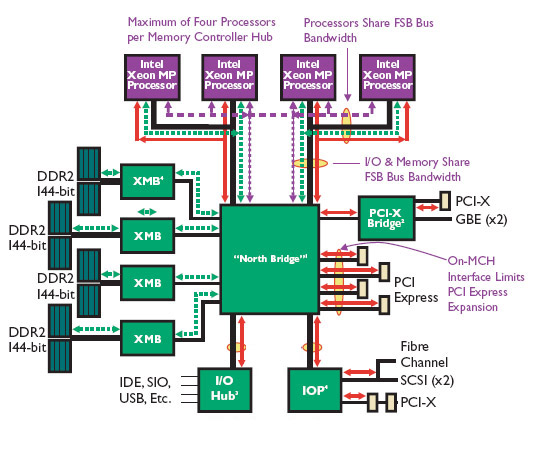
AMD Server Processor Roadmap
As we mentioned, there haven't been any changes to Opteron recently, besides a speed bump and a move to 1GHz HyperTransport last year. Although the Opteron is getting up there in years, it's still a proven, scalable architecture. AMD does have some changes on the horizon for Opteron, though: DDR2 and a new socket. Will that be enough to keep them on top when Woodcrest is released? Only time will tell, but if our recent preview of socket AM2 performance is any indication, changing the server platforms to DDR2 isn't likely to increase performance much over current offerings.
We haven't seen any indications of pending changes other than the socket and memory controller. AMD is being very tightlipped about their plans for Opteron, but below is a synopsis of what we know is on the books.
Highlights
- DDR2 (2006)
- AM2 Socket (2006
- Multi Core (2007)
- FBDIMM (2007)
- Shared L3 Cache (2007)
Intel Server Processor Roadmap
Intel has actually been quite forthcoming about what they are working on, for obvious reasons. They need the market to know that they are going to be competitive, and how that will be accomplished. The first two quarters of 2006 will introduce the Bensley platform, which brings the Dempsey Dual Core Xeons.
The last two quarters of the year are where things get interesting. Woodcrest is to debut in the second half of this year. Woodcrest is supposed to drop power consumption from 130W (Dempsey) to <80W, which should make a huge impact on the power consumption numbers we measured earlier this year for Dempsey. Note that Woodcrest processors will also run on the Bensley platform.
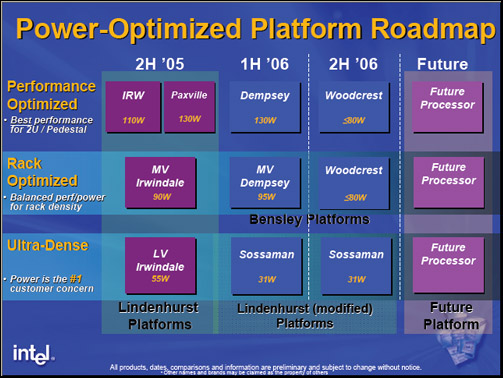
Software Configuration
Windows Tests
Windows 2003 Enterprise 64-bit was used for the tests along with SQL Server 2005 64-bit.
Linux Tests
CentOS 4.2 x86_64 was used along with MySQL 5.0.18 x86_64.
Hardware Configuration
Intel Paxville System
Quad 3.0 GHz Paxville Dual Core Processors (667Mhz FSB / 2x2MB L2)
E8500 (Twin Castle 4S) Xeon MP Truland Platform
16GB DDR2
8 x 18GB 15,000RPM Ultra320 SCSI drives in RAID-0
LSI Logic 320-2 SCSI Raid Controller
HP DL585 Opteron System
HP Proliant DL585 System
Quad Opteron 880 Dual Core Processors
16GB DDR
8 x 18GB 15,000RPM Ultra320 SCSI drives in RAID-0
LSI Logic 320-2 SCSI Raid Controller
Benchmark Configuration
Many of you will notice that we've finally transitioned our benchmark platform to 64-bit. It's been a long road getting there; we were constantly trying out builds of SQL 2005 64-bit as it was in development, and had mixed results. The final build produced viable numbers, and we've fully transitioned to SQL 2005 for all future benchmarks.
Our goal throughout the tests was a constant CPU usage of 80-90%; we didn't want to reach the point of system saturation, nor did we want the systems to have too many idle cycles. Each test was first verified and then run 3 times. The standard deviation for the tests is 3-4%. We then averaged the set of three runs to produce the final result.
Linux MySQL Tests
SysBench 0.4.3 was used for the MySQL tests. We ran 4 different tests for each platform. The first two tests consisted of accessing 1M rows in a read-write scenario, and 1M rows in a read-only scenario. The second tests were the same only with 10M rows.
MSSQL Forum Test
The forum benchmark is a standard mid-tier OLTP test, which was made by replicating live query data from our forum database during peak hours. We took those queries and then record them in an XML file, with random row ID generators to handle keeping the test as real-world as possible. We wrote a C# application which takes the test and plays it back using several threads to stress the database to a desired level.
Dell DVD Store
The DVD Store Version 2 (DS2) is a complete online e-commerce test application, with a backend database component, a web application layer, and driver programs. The goal in designing the database component as well as the mid-tier application was to utilize many advanced database features (transactions, stored procedures, triggers, referential integrity) while keeping the database easy to install and understand. The DS2 workload may be used to test databases or as a stress tool for any purpose. The test is maintained by Dave Jaffe and Todd Muirhead from Dell. We configured the test to hit the database directly, instead of using a web-tier; we're testing database performance, and that removes any unneeded complexity and possible discrepancies.
Benchmark Results
The Opteron leads the way in every test, which isn't surprising. As we've said in the past the current Xeon is hindered by the front-side bus. Trying to shove a giant beach ball into a basket ball hoop - with thirty other people waiting to try the same thing - has a serious impact on scalability. All of the tests are fairly consistent, and the Opteron averages a 36-51% lead over the Paxville system.
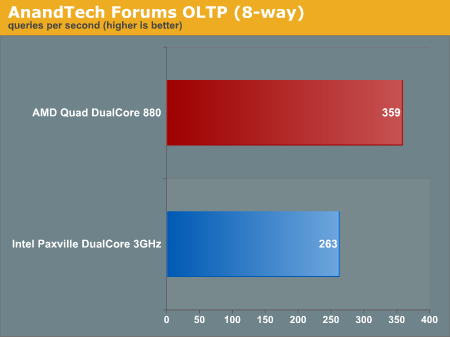
The forum test represents a medium workload OLTP application, and the Opteron comes out ahead by approximately 36%.
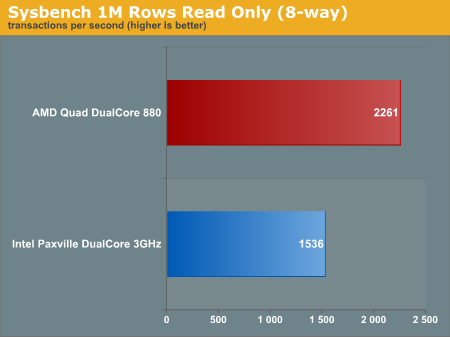

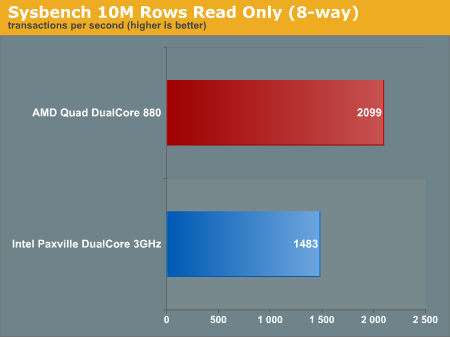

Opteron averages anywhere from 40-51% over Paxville during this test, representative of a medium workload OLTP application.
Dell DVD Store
The Dell DVD store test is a new addition to our test suite, and essentially replaced our old order-entry test.

Here the Opteron leads by 41%. This test is indicative of an enterprise level e-commerce application.
Conclusion
At present, Opteron has a commanding lead in 8-way configurations. Looking at the prices of the processors we used, AMD has the advantage there as well. The Xeon MP 3.0 GHz processors currently cost upwards of $3000 each, whereas Opteron 880 are about $1000 less. Of course, for enterprise servers price is less of a concern; performance, scalability, and reliability take precedence. Reliability might be a tie, but that's about as close as Intel's Xeon MP currently comes to Opteron.
Nothing that we've written in this article should be a surprise. All of our Opteron benchmarks have shown the scalability of the K8 architecture. The elusive question is, what next? AMD is completely quiet about anything other than a socket and memory controller change; is that enough to fend off Woodcrest? We speculate that the end of the year will be interesting to say the least. What we've seen of initial Bensley performance looks promising, and the Woodcrest addition later on should kick the competition up another notch. If everything goes as planned, Intel may just regain lost ground.







